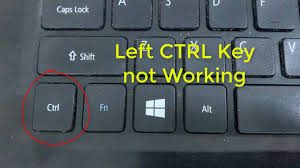Let’s face it, the Ctrl key is a productivity powerhouse. From copying and pasting text to taking screenshots and launching shortcuts, it’s like a mini-command center for your keyboard. But what happens when your trusty Ctrl key seems to be on strike? Fear not, fellow typists! Here’s a breakdown on how to test your Ctrl key and get it back in fighting form.
Why the Ctrl Key?
There’s a reason the Ctrl key (short for “control”) occupies prime real estate on your keyboard. It acts like a magical key modifier, unleashing a whole new set of functions when used in combination with other keys. From copying and pasting (Ctrl + C and Ctrl + V, respectively) to selecting text (Ctrl + A) and using keyboard shortcuts (like Ctrl + Alt + Delete to open Task Manager), the Ctrl key is a master of efficiency.
The Wonderful World of Ctrl
While most keyboards have a single Ctrl key on the left side (sometimes paired with another on the right side for ergonomic reasons), there are variations. Some keyboards, especially gaming keyboards, might have a programmable Ctrl key that allows you to assign custom functions. No matter the type, though, the basic functionality of the Ctrl key remains the same – to unleash the power of keyboard shortcuts!
Benefits of a Healthy Ctrl Key
A healthy Ctrl key translates to a smoother and faster workflow. Think about it: how many times a day do you rely on Ctrl + C and Ctrl + V? A malfunctioning Ctrl key can disrupt your typing rhythm and add unnecessary clicks to your tasks. Plus, it can hinder your ability to use those nifty keyboard shortcuts that save you precious time.
Steps to Test Your Ctrl Key
Now, onto the main event: testing your Ctrl key. Here are three methods you can try, from the simplest to slightly more involve:
The Classic Copy-Paste Test
This is the quickest way to see if your Ctrl key is functioning. Open any text editor (like Notepad) or a web page where you can type. Type some text, then hold down the Ctrl key and press C. This should copy the text. Now, place your cursor at a new location and hold Ctrl again while pressing V. If the copied text appears, congratulations! Your Ctrl key is a champ.
Embrace the Keyboard Tester
For a more comprehensive test, head online and search for keyboard tester. These websites display a virtual keyboard layout where you can press any key and see it highlighted on the screen. Find the Ctrl key on the virtual keyboard and press the physical Ctrl key on your keyboard. If the virtual Ctrl key lights up, you’re good to go! Keyboard testers are also handy for checking other keys that might be causing trouble.
The Shortcut Sleuth
This method involves trying a few common keyboard shortcuts that rely on the Ctrl key. Here is a couple to test:
Ctrl + Alt + Delete: This should bring up the familiar Windows security options menu.
Ctrl + P: This shortcut usually opens the print dialog box for the current program you’re using.
If these shortcuts work as expected, then your Ctrl key is most likely functioning properly.
So, Your Ctrl Key Failed the Test? Don’t Panic!
If none of the above methods produced the desired results, there might be an issue with your Ctrl key. Here are a couple of troubleshooting steps you can try:
Restart Your Computer: A simple restart can sometimes fix minor glitches that might be affecting your keyboard functionality.
Clean You’re Keyboard: Dust, crumbs, or even spilled liquids can sometimes interfere with key registration. Gently clean your keyboard with a compressed air can or a soft brush.
Check for Driver Updates: Outdated keyboard drivers might cause issues with certain keys. Head to your device manager and check if there are any updates available for your keyboard driver.
Time for a New Keyboard: If none of the above solutions work, then your keyboard might be on its last legs. Consider investing in a new one!
FAQs
What if I have multiple Ctrl keys on my keyboard?
Most methods mentioned above will work for any Ctrl key on your keyboard. Just make sure you’re pressing the correct one for the desired shortcut.
Can a stuck Ctrl key cause problems?
Absolutely! If your Ctrl key is stuck in the “pressed” position, it might continuously trigger keyboard shortcuts unintentionally. Restarting your computer or trying to gently un-stick the key might help. In severe cases, a new keyboard might be necessary.
Conclusion
A functioning Ctrl key is the cornerstone of a smooth and efficient typing experience. By following the testing methods outlined above, you can quickly diagnose any issues and get your Ctrl key back in fighting form. Remember, a simple restart, cleaning, or driver update might be all it takes. If worse comes to worst, a new keyboard awaits! So, the next time your Ctrl key seems to be acting up, don’t despair. With a little troubleshooting, you’ll be back to mastering keyboard shortcuts and conquering your tasks in no time!
